The last year has been challenging for dealers across virtually every industry—and the construction industry was no different. But despite supply chain challenges and social distancing guidelines, the construction industry is still plowing forward.
No doubt, this is an exciting time for construction equipment dealers. Increased investments in development, consumer habits, and technological advancements are shaping construction industry trends for 2022 and beyond.
We asked speakers at this year’s AED summit, along with other construction equipment industry experts, to share their insights into what construction equipment dealers can expect in the year ahead. Here are six construction industry trends to watch in 2022 and beyond.
1. Labor and Environmental Policy Changes
You’ve likely already heard rumblings of potential changes to labor and environmental laws. These changes mean your dealership could face more stringent regulations, which could impact operations at your dealership.
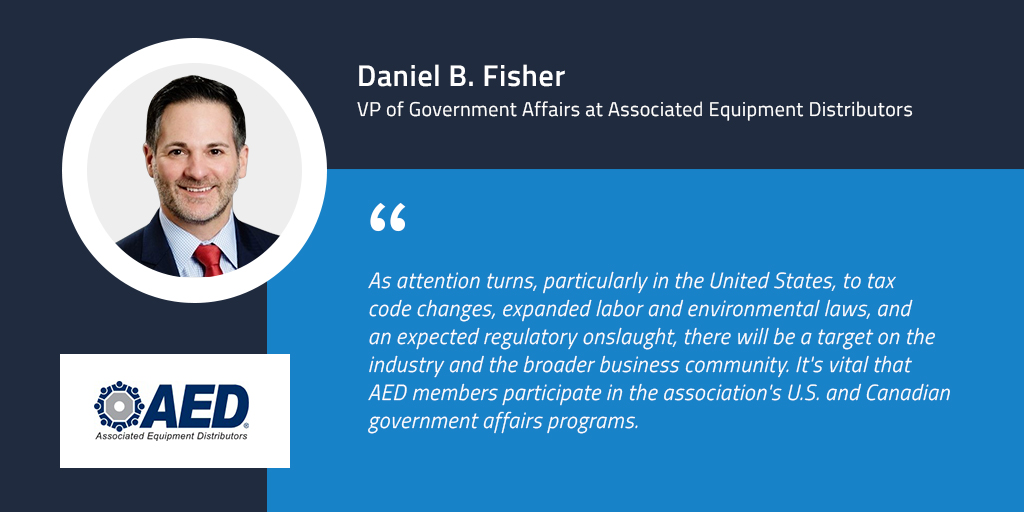
“Equipment dealers can expect to face public policy challenges given the political dynamics in both Washington and Ottawa. Of course, there are significant opportunities as infrastructure investments are considered.
However, as attention turns, particularly in the United States, to tax code changes, expanded labor and environmental laws, and an expected regulatory onslaught, there will be a target on the industry and the broader business community.
It’s vital that AED members participate in the association’s U.S. and Canadian government affairs programs. There are many ways to get involved, but it’s never been more important for AED members to engage in the policymaking process.”
Daniel B. Fisher, VP of Government Affairs at Associated Equipment Distributors
As new regulations roll out, it will be important for dealers to ensure their team is trained on compliance standards.
2. Labor Shortages
As the saying goes, good help is hard to find. Labor shortages, particularly technician shortages, have been an industry-wide problem for a while now. Now, with the increased demand for new infrastructure, many equipment dealerships need to do more with less. That means building a team where members can wear multiple hats – from tech literacy to sales to customer success.
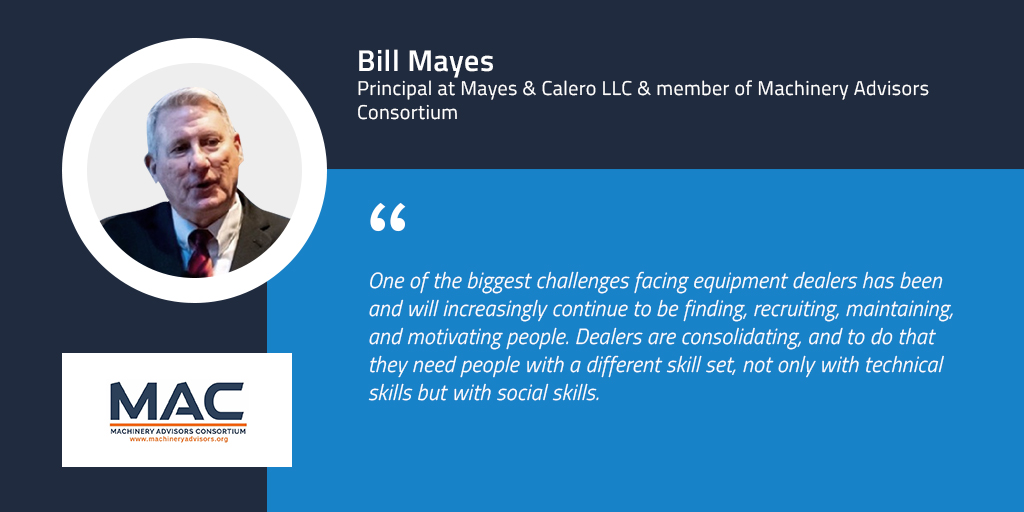
“One of the biggest challenges facing equipment dealers has been and will increasingly continue to be finding, recruiting, maintaining, and motivating people. Dealers are consolidating, and to do that they need people with a different skill set, not only with technical skills but with social skills.
The new workforce will not accept the ‘my way or the highway’ mentality of the past. Don’t think of this as good or bad, it simply is what it is. Dealers will need to ensure that they are nurturing and growing a group of new managers that can grow the business based on a common vision without having to be told what to do and how to do it every step of the way. The good news is that this is trainable behavior.”
Bill Mayes, Principal at Mayes & Calero LLC & member of Machinery Advisors Consortium
The risk of operating with a lean team? Burnout.
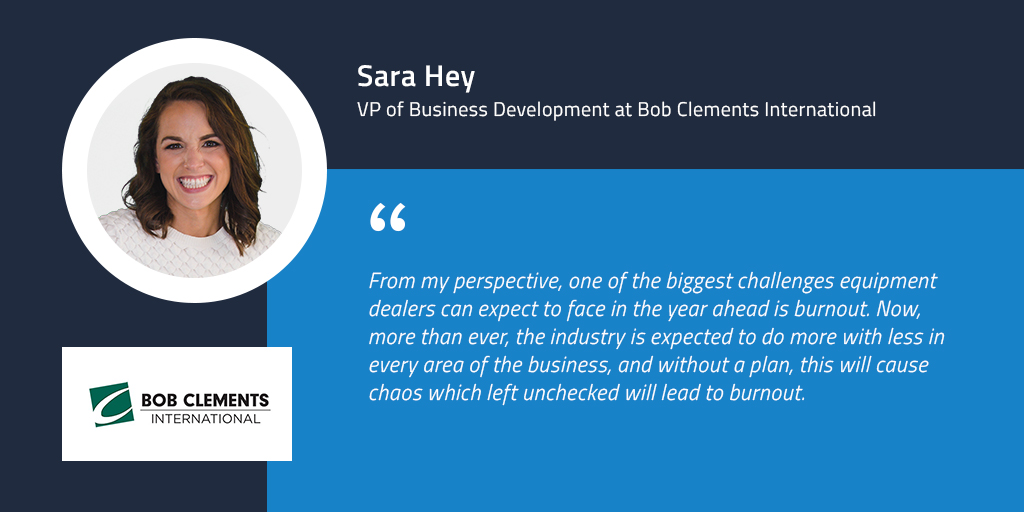
“From my perspective, one of the biggest challenges equipment dealers can expect to face in the year ahead is burnout. Now, more than ever, the industry is expected to do more with less in every area of the business, and without a plan, this will cause chaos which left unchecked will lead to burnout.
Anytime there is chaos in the dealership, it costs you both money and your sanity, and the way you combat chaos is with good processes.”
Sara Hey, VP of Business Development at Bob Clements International
To avoid team burnout, more and more equipment dealers are turning to technology to streamline processes and increase their team’s efficiency. Tools like DIS Service Logistics and DIS Service Scheduling help teams cut down on time-consuming tasks, prioritize work, and fix service bottlenecks.
3. Mobile Service Applications
Gone are the days where technicians needed to be chained to their desktops. Now, thanks to mobile apps, teams can get more done on the spot, without needing to run back and forth across the lot. This can make working on jobs just that bit less hectic—one of the many ways technology is helping make the construction industry more efficient.

“One of the biggest trends we are seeing over the last several years is the need for doing business outside the walls of the dealership. Particularly, we’re seeing a demand for field technician tools like Service Logistics. The ability to track time, add parts, take pictures, and get a signature at the point of service will not only make the service department more efficient but present a professional look to the end customer.”
Randy McIntyre, General Manager at DIS
4. Lean Construction
This year, we’re seeing a lot more focus put on sustainability. That’s why lean construction will only increase in relevancy this year and next. Lean construction focuses on reducing process waste while maximizing efficiency.
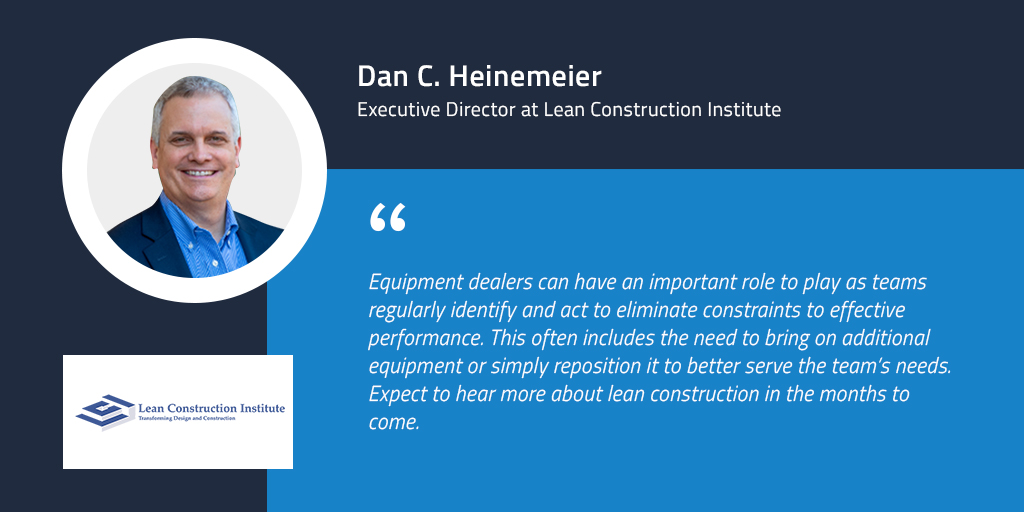
“Lean Construction has been around for many years now, but it continues to catch on in the industry thanks to the ways in which it promotes enhanced productivity and collaboration within project teams. Its key tenets include reducing waste and promoting value for project stakeholders.
Equipment dealers can have an important role to play as teams regularly identify and act to eliminate constraints to effective performance. This often includes the need to bring on additional equipment or simply reposition it to better serve the team’s needs. Expect to hear more about lean construction in the months to come.”
Dan C. Heinemeier, Executive Director at Lean Construction Institute
5. Focus on Customer Experience
Customer experience is a customer’s holistic experience of your business—from their perception of your ads to their experience talking to your team throughout the sales/service, to your communications with them post-sale/service.
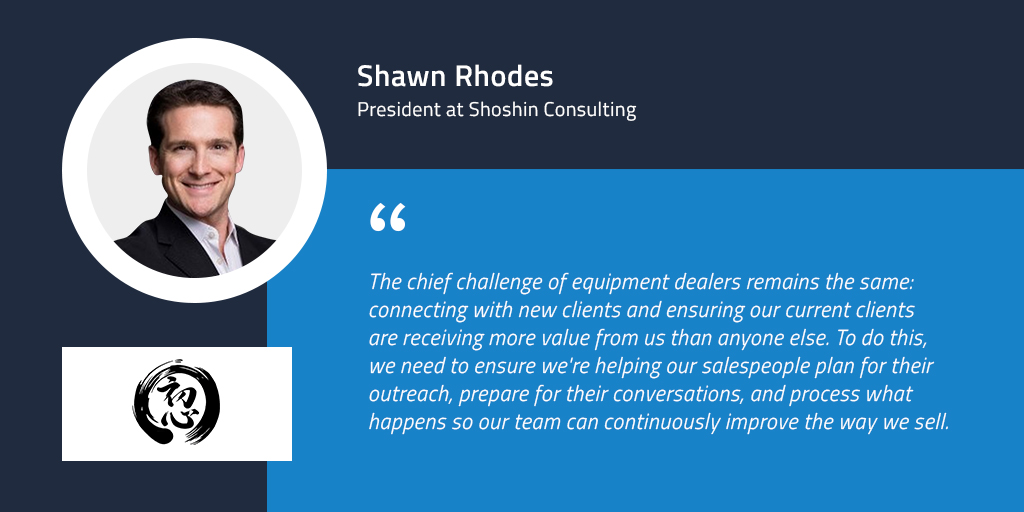
According to PWC, 86% of buyers are willing to pay more for a great customer experience. Equipment dealers can create a great customer experience by anticipating their customers’ needs, maintaining ongoing communication throughout the sales and service process, and nurturing customer loyalty post-sale.
Not only that, but to create a great customer experience, you also need your team to be aligned on what differentiates your dealership from the competition, so that your messaging is consistent internally and externally. You will also need to address internal communication constraints which, according to Equipment Dealer Magazine, are one of the largest issues that dealerships face.
“Despite the pandemic, the chief challenge of equipment dealers remains the same: connecting with new clients and ensuring our current clients are receiving more value from us than anyone else. To do this, we need to ensure we’re helping our salespeople plan for their outreach, prepare for their conversations, and process what happens so our team can continuously improve the way we sell.”
Shawn Rhodes, President at Shoshin Consulting
6. Online Marketing and Sales
In 2020, many equipment dealers had to ramp up their online marketing to attract new customers while social distancing guidelines were in effect.
But the need for businesses to have a strong online presence preceded the pandemic. Customers have already been trending towards researching businesses online before deciding where to make their purchases. That means that having a strong online presence is more important than ever, including an up-to-date website, online reviews from customers, and active social media accounts.
In fact, according to a survey by Bizrate Insights, over 25% of respondents only trust a rating if it has between 11 and 50 reviews. What’s more, Millennials have a greater tendency to research a business online before making their decision to buy.
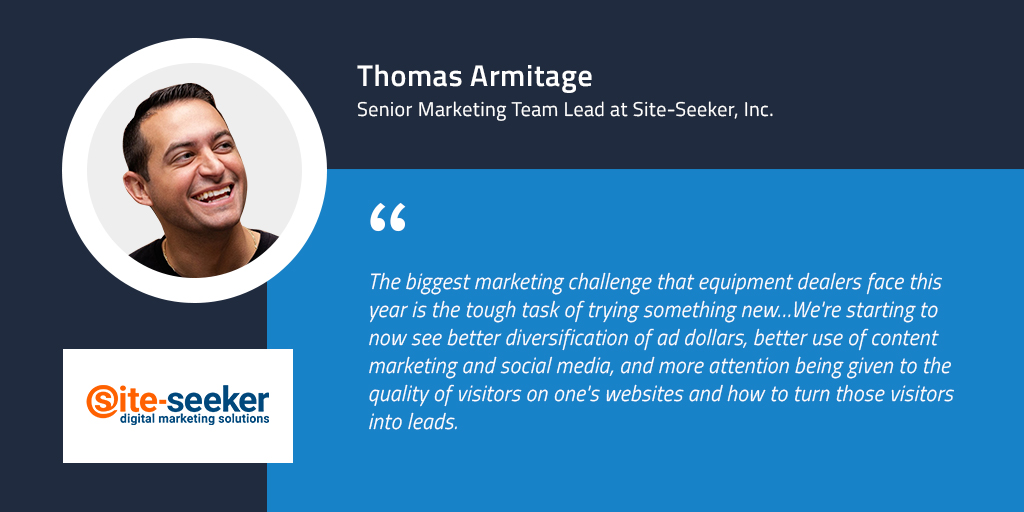
“The biggest marketing challenge that equipment dealers face this year is the tough task of trying something new. For a long time, folks (across many industries) got comfortable with what they were doing and got lazy with measurement. Buying lead lists, putting time into Twitter, sending out generic emails.
COVID was a wake-up call. Not just because it affected the books, but because it caused changes to both work and buying habits. It forced marketers to stop and think about what’s working and what’s not. We’re starting to now see better diversification of ad dollars, better use of content marketing and social media, and more attention being given to the quality of visitors on one’s websites and how to turn those visitors into leads.
It’s not the time to get scared or shy away from new tactics. It’s time to embrace the change.”
Thomas Armitage, Senior Marketing Team Lead at Site-Seeker, Inc.
Adapting to Meet the Changes Ahead
The common thread throughout all these trends is technology. Folks in the construction industry are coming up with amazing solutions to address the challenges they face. By embracing new technology and looking for ways to optimize processes at their dealership, equipment dealers can build a bright future for their business.
Want to learn how one of Western’s Colorado’s biggest construction and farm equipment dealerships is bridging technology and generational gaps? Click here to read how Western Implement is using technology to help their business thrive in the changing market.
![Fixed Absorption: Your Dealership’s Recession Shield [Infographic]](https://www.discorp.com/wp-content/uploads/2025/04/Blog-prev-190x190.jpg)


